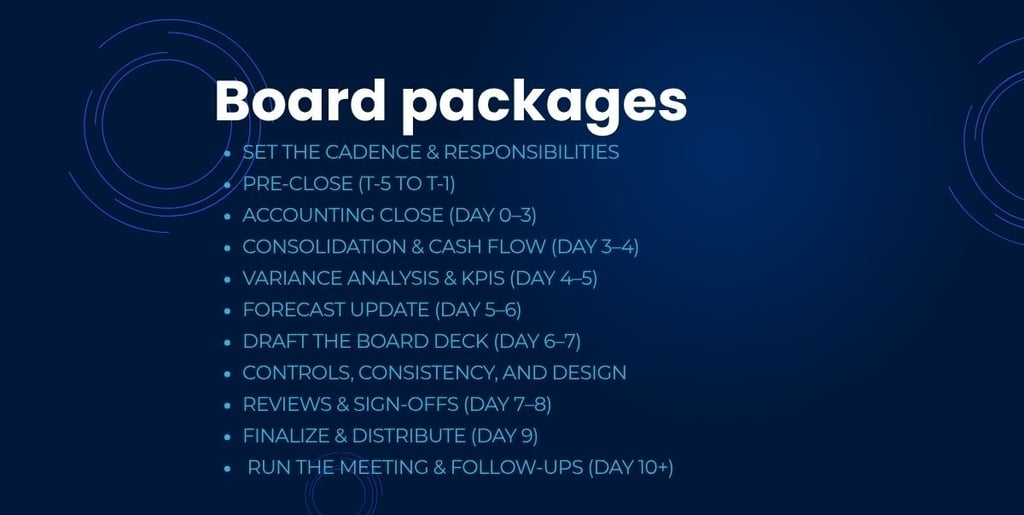Board Package
Comprehensive reports for strategic decision-making.
Professor Abdullahel Kafi
What Is Monthly Board Package
A monthly Board package is a comprehensive financial and operational report prepared for senior management and the Board of Directors to support strategic decision-making. It consolidates key financial statements—Income Statement, Balance Sheet, and Cash Flow—along with variance analyses, forecasts, and performance KPIs. Beyond numbers, it translates financial data into actionable insights, highlighting trends, risks, and opportunities. A well-prepared Board package ensures transparency, governance, and accountability while aligning executives on business performance. Delivered consistently each month, it serves as the organization’s primary tool for monitoring progress, evaluating strategy execution, and driving informed, data-based leadership decisions.


How To Prepare
Here’s a practical, repeatable playbook to build a monthly Board package with complete financials.
1) Set the cadence & responsibilities
Close calendar: Day-by-day schedule (T-5 to Day +10).
RACI: Finance owns P&L/BS/CF; FP&A owns variances/forecast; Ops/HR/Sales own functional KPIs; Legal reviews disclosures.
Data stack: ERP (GL, AP/AR, Inventory), Payroll/HRIS, CRM, Data warehouse/BI, close tool (e.g., BlackLine/FloQast).
2) Pre-close (T-5 to T-1)
Lock accounting policies (rev-rec, capitalization, accruals).
Confirm cutoffs (billing, receipts, payroll, inventory counts).
Circulate open items list (PO accruals, intercompany, CAPEX, FX revals).
Freeze chart of accounts and entity mapping for consolidation.
3) Accounting close (Day 0–3)
Post final journal entries (accruals/deferrals, amort, depreciation, taxes).
Complete reconciliations for cash, AR, AP, inventory, fixed assets, debt, equity.
Intercompany: match, eliminate, and reconcile FX.
Revenue: cutoff tests, unbilled/billed tie-outs; deferred revenue roll-forward.
Controller sign-off that GL is complete & accurate.
4) Consolidation & cash flow (Day 3–4)
Run multi-entity consolidation with eliminations and minority interest.
Build cash flow (indirect) from the closed P&L/BS; reconcile to bank.
Produce trial balance and roll-forwards (AR, Inventory, PP&E, Deferred rev, Debt).
5) Variance analysis & KPIs (Day 4–5)
Create BvA (Budget vs Actual), PvA (Prior month), YoY tables.
Prepare bridges: Revenue bridge (price/volume/mix), Gross margin bridge (cost/efficiency/FX), Operating income bridge (Opex drivers).
Compute unit economics and operational KPIs (e.g., CAC/LTV, churn, conversion, utilization, throughput, DSO/DPO/DOH, cash conversion cycle).
Add flux commentary: what moved, why, durable vs one-time, action items.
6) Forecast update (Day 5–6)
Refresh rolling 12–18-month forecast and full-year outlook.
Sensitivities: base / downside / upside; include cash runway and headcount plan.
Covenants & compliance: current and projected, with headroom.
7) Draft the Board deck (Day 6–7)
Suggested Table of Contents (12–20 slides + appendix):
Executive Summary (3–5 bullets: revenue, margin, cash, outlook)
Scorecard (traffic-light KPIs vs targets)
P&L (monthly + YTD, BvA/PvA/YoY with % and $ deltas)
Balance Sheet (key accounts & ratios)
Cash Flow & Liquidity (cash bridge; runway)
Revenue Detail (segments/products/regions; pipeline snapshot if relevant)
Margin & Cost (COGS drivers; Opex by function; hiring vs plan)
Operational KPIs (cohorts, capacity, quality, cycle times)
Forecast & Guidance (R12 and FY; scenarios)
Risks & Mitigations (top 5 with owners/dates)
Strategic Initiatives (ERP, pricing, expansion, major contracts)
Requests/Decisions (capital, hires, policy changes)
Appendix: reconciliations, roll-forwards, non-GAAP to GAAP, AR aging, inventory, capex, debt schedule, policy notes.
8) Controls, consistency, and design
Single source of truth: Pull all numbers from the same close package.
Version control: v0.1 draft → v1.0 final (date-stamped).
Formatting: consistent chart scales; label deltas; footnote assumptions; define every KPI once.
Non-GAAP: present clearly and reconcile to GAAP in appendix.
Materiality & one-timers: call out separately (and remove from run-rate).
9) Reviews & sign-offs (Day 7–8)
Controller: financial statements & disclosures.
FP&A: variances, bridges, forecast.
Function heads: KPI accuracy & commentary.
CEO/CFO: narrative, risks, and Board asks finalized.
10) Finalize & distribute (Day 9)
Export to PDF and editable deck; apply Confidential watermark.
Send 48–72 hours before the meeting with an agenda and pre-reads (policy changes, contracts, capex memos).
11) Run the meeting & follow-ups (Day 10+)
Lead with Executive Summary and decisions needed.
Park deep dives to appendix to keep flow.
After the meeting: circulate action log (owner, due date) and file the package to the Board portal/DMS.
Pro tips & common pitfalls
Pro tips: Freeze numbers early; spend time on why they moved. Use bridges and traffic-lights to focus attention. Keep deck to decision-ready insights.
Pitfalls: Multiple data versions, inconsistent definitions, burying one-time items, and sending too late for Board review.

